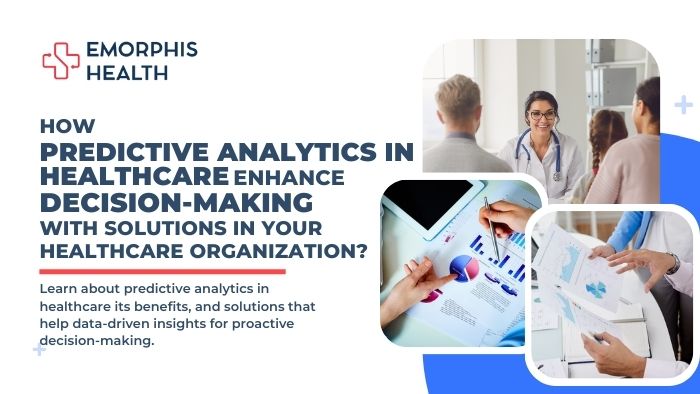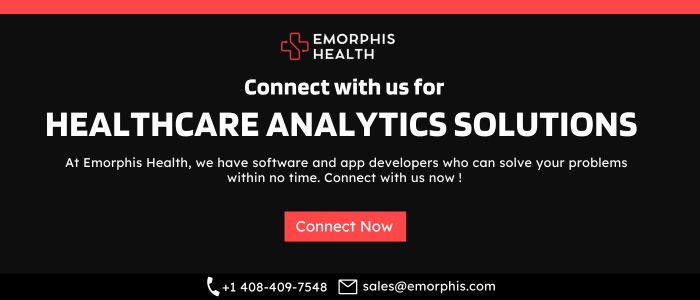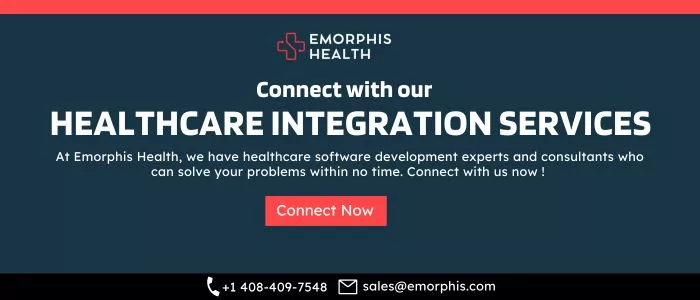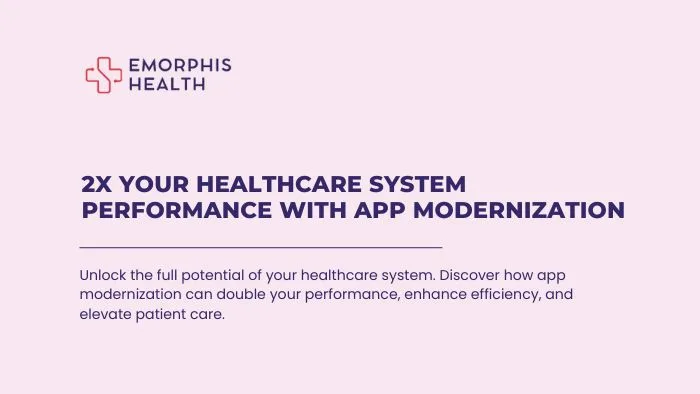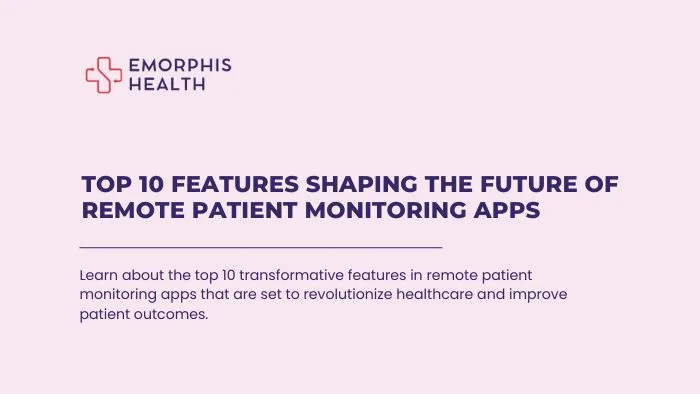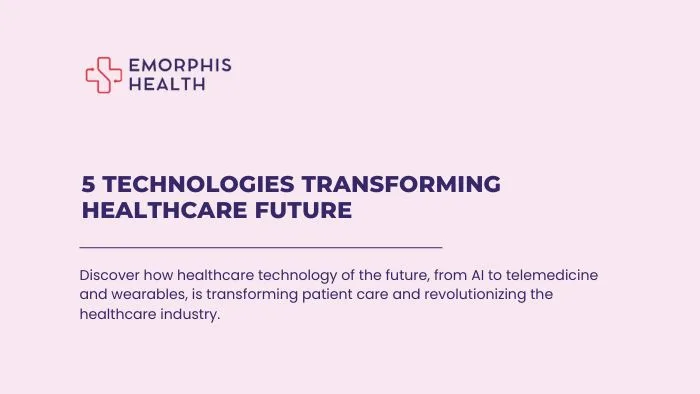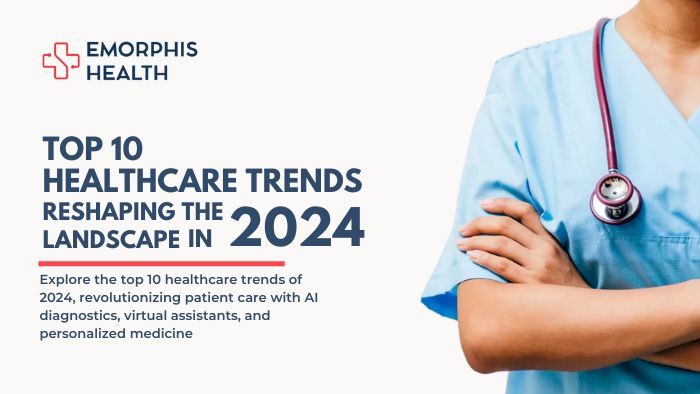Introduction to Predictive Analytics in Healthcare
See Contents
- 1 Introduction to Predictive Analytics in Healthcare
- 2 Benefits of Implementing Predictive Analytics
- 3 Impact on Decision-Making with Predictive Analytics Across Various Verticals of Healthcare
- 4 What are the popular software solutions that can be developed for Predictive Analytics in Healthcare?
- 5 Addressing Challenges and Considerations in Predictive Analytics Implementation
- 6 The Evolving Landscape of Predictive Analytics
- 7 Conclusion
In the rapidly evolving landscape of healthcare, the marriage of data and advanced analytics has given rise to a transformative force: predictive analytics. This powerful tool harnesses the potential of vast datasets to forecast future trends, enabling healthcare organizations to make informed decisions that can shape the trajectory of patient care and operational strategies.
Understanding the Role of Predictive Analytics in Decision-Making
Predictive analytics involves the utilization of statistical algorithms and machine learning techniques to analyze historical data and identify patterns that can be extrapolated to predict future outcomes. In the context of healthcare, this entails examining patient records, treatment outcomes, and various operational metrics to gain insights that guide decision-making processes.
At its core, predictive analytics goes beyond the traditional realm of reactive care. Instead of responding to events as they unfold, healthcare providers can now anticipate and proactively address potential challenges, creating a paradigm shift towards preventive and personalized medicine.
Benefits of Implementing Predictive Analytics
Predictive analytics has become a cornerstone of data-driven decision-making across various industries, offering a multitude of advantages that empower organizations to proactively address challenges and capitalize on opportunities. Here are the key benefits of implementing predictive analytics:
1. Proactive Decision-Making
Anticipate Future Trends: Predictive analytics allows organizations to anticipate future trends and behaviors based on historical data, enabling proactive decision-making rather than reactive responses.
2. Improved Operational Efficiency
Optimized Resource Allocation: By forecasting demand and operational needs, predictive analytics helps organizations optimize resource allocation, leading to increased efficiency and reduced operational costs.
3. Enhanced Customer Satisfaction
Personalized Experiences: Predictive analytics enables organizations to understand customer preferences and behavior, facilitating the delivery of personalized products, services, and experiences that enhance customer satisfaction and loyalty.
4. Risk Mitigation and Fraud Prevention
Identify Potential Risks: Predictive analytics identifies potential risks and enables organizations to take preventive measures. In the financial sector, it aids in fraud detection by recognizing patterns indicative of fraudulent activities.
5. Cost Savings and Financial Optimization
Preventive Cost Management: Predictive analytics assists in predicting costs and optimizing financial planning. By identifying areas of cost containment, organizations can achieve significant cost savings and improve financial efficiency.
6. Efficient Supply Chain Management
Inventory Optimization: In supply chain management, predictive analytics optimizes inventory levels, preventing overstock or stockouts, and improving overall supply chain efficiency.
7. Human Resource Optimization
Workforce Planning: Predictive analytics aids in workforce planning by forecasting staffing needs based on demand, ensuring optimal human resource allocation, and improving overall workforce efficiency.
8. Quality Improvement
Enhanced Patient Outcomes: In healthcare, predictive analytics contributes to improved patient outcomes by identifying factors influencing health outcomes and facilitating proactive interventions.
9. Strategic Financial Planning
Accurate Budgeting: Predictive analytics provides accurate financial projections, facilitating strategic budget planning and ensuring that resources are allocated where they are needed most.
10. Marketing Effectiveness
Targeted Campaigns: Predictive analytics enhances marketing effectiveness by identifying target audiences and predicting which strategies will be most successful. This leads to more targeted and impactful marketing campaigns.
11. Increased Revenue
Revenue Cycle Management: Predictive analytics assists in optimizing revenue cycles by predicting claims denials, reducing revenue loss, and ensuring efficient financial operations.
12. Strategic Planning and Forecasting
Future Planning: Predictive analytics provides valuable insights for strategic planning by forecasting future trends, allowing organizations to align their strategies with changing market dynamics.
13. Competitive Advantage
Data-Driven Decision-Making: Organizations that leverage predictive analytics gain a competitive advantage by making data-driven decisions, staying ahead of the curve, and adapting quickly to market changes.
14. Time and Resource Efficiency
Automated Decision-Making: Predictive analytics automates decision-making processes, saving time and resources. This allows organizations to focus on strategic initiatives rather than routine tasks.
15. Improved Patient Care
Preventive Healthcare: In healthcare, predictive analytics supports preventive care by identifying individuals at risk of specific diseases, enabling early interventions and personalized healthcare plans.
The implementation of predictive analytics empowers organizations to transform data into strategic insights, fostering innovation, efficiency, and resilience in an increasingly competitive and dynamic business environment.
Do check the link to find the details of Integrated Health Solutions – Advancing Healthcare Delivery.
Impact on Decision-Making with Predictive Analytics Across Various Verticals of Healthcare
Predictive analytics has emerged as a game-changer in healthcare, revolutionizing decision-making processes across diverse verticals. Let’s explore the profound impact in key areas of clinical operations, patient care, financial management, and strategic planning.
A. Clinical Operations
Patient Flow Optimization: Predictive analytics forecasts patient admission rates, enabling hospitals to optimize bed utilization, streamline patient flow, and enhance overall clinical operations.
Readmission Risk Prediction: Identifying patients at risk of readmission allows healthcare providers to implement targeted interventions, improving post-discharge care and reducing readmission rates.
B. Population Health Management
Disease Prevention and Management: Predictive analytics assists in identifying populations at risk for specific diseases, enabling proactive preventive measures and personalized disease management.
Chronic Disease Management: For chronic conditions, predictive analytics aids in designing personalized care plans, optimizing resource allocation, and improving the long-term management of chronic diseases.
C. Revenue Cycle Management
Claims Denial Prediction: Predictive analytics helps predict potential claims denials, allowing organizations to address issues before submission, reducing revenue loss, and improving the overall revenue cycle.
Cash Flow Forecasting: By analyzing historical financial data, predictive analytics provides accurate cash flow forecasts, facilitating strategic financial planning and ensuring fiscal stability.
D. Supply Chain Management
Inventory Optimization: Predictive analytics assists in optimizing inventory levels, ensuring healthcare providers have the right supplies at the right time, minimizing waste, and reducing costs.
Demand Forecasting: Accurate demand forecasting ensures that supply chain management aligns with patient needs, preventing stockouts or excess inventory.
E. Human Resources
Workforce Planning: Predictive analytics aids in workforce planning by forecasting staffing needs based on patient admissions and operational requirements, optimizing human resource allocation.
Employee Retention: By analyzing factors contributing to employee turnover, predictive analytics supports strategies for employee retention and talent development.
F. Quality Improvement
Patient Outcomes: Predictive analytics contributes to quality improvement by analyzing patient data to identify factors influencing outcomes. This facilitates interventions to enhance overall patient care and satisfaction.
Adverse Event Prediction: Identifying potential adverse events allows for proactive measures to prevent complications, ensuring a focus on patient safety and quality care.
G. Finance and Budgeting
Budget Planning: Predictive analytics supports strategic budget planning by providing accurate projections based on historical financial data, ensuring efficient resource allocation.
Fraud Detection: In finance, predictive analytics aids in fraud detection by identifying patterns indicative of fraudulent activities, safeguarding against financial losses.
H. Marketing and Patient Engagement
Targeted Marketing Campaigns: Predictive analytics enhances marketing strategies by identifying the most receptive audience, leading to targeted campaigns that resonate with specific demographics.
Patient Engagement: By analyzing patient data, predictive analytics enables personalized engagement strategies, improving patient communication and satisfaction.
What are the popular software solutions that can be developed for Predictive Analytics in Healthcare?
Predictive analytics in healthcare involves using data, statistical algorithms, and machine learning techniques to identify the likelihood of future outcomes based on historical data. Several software solutions can be developed for predictive analytics in healthcare. Here are some popular types of software solutions:
a. Electronic Health Record (EHR) Systems
EHR systems can be enhanced with predictive analytics modules to provide insights into patient outcomes, disease progression, and treatment effectiveness.
b. Clinical Decision Support Systems (CDSS)
CDSS can leverage predictive analytics to assist healthcare providers in making informed decisions by analyzing patient data and suggesting appropriate treatment plans.
c. Population Health Management Software
These tools help healthcare organizations identify and manage health trends within specific populations. Predictive analytics can be used to forecast disease outbreaks, allocate resources efficiently, and improve overall population health.
d. Readmission Prediction Software
Hospitals can develop software solutions that use predictive analytics to identify patients at high risk of readmission. This allows healthcare providers to intervene and provide additional support to prevent unnecessary hospitalizations.
e. Chronic Disease Management Systems
Software can be developed to monitor and manage chronic diseases by predicting patient health deterioration, recommending interventions, and personalizing treatment plans.
f. Remote Patient Monitoring Platforms
Predictive analytics can be incorporated into remote monitoring solutions to anticipate health events, such as changes in vital signs, and alert healthcare providers to potential issues before they escalate.
g. Fraud Detection and Prevention Systems
Healthcare organizations can develop software solutions that use predictive analytics to detect fraudulent activities, such as billing fraud or identity theft, helping to minimize financial losses.
h. Supply Chain Optimization Software
Predictive analytics can be applied to optimize the supply chain in healthcare, ensuring that the right medications, equipment, and resources are available when needed, thus improving operational efficiency.
i. Personalized Medicine Platforms
Software solutions can be developed to analyze patient data, including genetic information, to tailor treatment plans based on individual characteristics, increasing the effectiveness of medical interventions.
j. Health Risk Assessment Tools
These tools use predictive analytics to assess an individual’s health risks based on various factors such as lifestyle, genetics, and medical history, enabling personalized preventive care.
When developing software solutions for predictive analytics in healthcare, it’s crucial to prioritize data security, privacy, and compliance with healthcare regulations (such as HIPAA in the United States) to ensure the ethical and secure handling of sensitive patient information.
Click the link to check about Healthcare Software Product Engineering
Addressing Challenges and Considerations in Predictive Analytics Implementation
As organizations increasingly embrace predictive analytics to bolster decision-making, they encounter a host of challenges that demand strategic solutions. Addressing these challenges is pivotal for successful implementation. Let’s explore key hurdles and effective strategies:
Data Quality and Integration
- Challenge: Poor data quality and integration issues can hinder predictive model accuracy.
- Solution: Implement robust data governance practices, perform data quality checks, and invest in integration tools for unifying diverse data sources.
Lack of Skilled Talent
- Challenge: Additionally, a scarcity of skilled data scientists impedes effective implementation.
- Solution: Invest in training programs, hire skilled professionals, and consider collaboration with external experts and analytics service providers.
Interpretability and Explainability
- Challenge: Black-box models, as a matter of fact, lack transparency, complicating interpretation.
- Solution: Prioritize interpretable models like decision trees and develop techniques for explaining complex model outputs.
Ethical Considerations
- Challenge: Predictive analytics may raise ethical concerns, especially regarding bias, privacy, and the responsible use of data.
- Solution: Establish ethical guidelines, conduct thorough impact assessments, and prioritize fairness and transparency in algorithmic decision-making.
Scalability
- Challenge: As data volumes grow, there may be challenges in scaling predictive analytics solutions.
- Solution: Adopt scalable technologies, leverage cloud-based platforms, and ensure that the infrastructure can accommodate increasing data loads.
Overcoming Resistance to Change
- Challenge: Resistance from stakeholders who are accustomed to traditional decision-making methods.
- Solution: Develop a change management strategy, provide training, and communicate the benefits of predictive analytics to gain organizational buy-in.
Cost Constraints
- Challenge: Implementation costs, including technology investments, can be a barrier.
- Solution: Conduct a cost-benefit analysis, explore cost-effective solutions, and consider phased implementations to manage expenses.
Model Accuracy and Validation
- Challenge: Predictive models may not always perform as expected, leading to inaccurate predictions.
- Solution: Implement rigorous model validation processes, continuously monitor performance, and iterate on models to improve accuracy over time.
Regulatory Compliance
- Challenge: Predictive analytics may be subject to industry-specific regulations and compliance requirements.
- Solution: Stay informed about relevant regulations, implement measures for compliance, and engage legal experts to navigate the regulatory landscape.
Security Concerns
- Challenge: Predictive analytics involves handling sensitive data and raising security concerns.
- Solution: Prioritize data security measures, implement encryption, and comply with data protection standards.
Integration with Existing Systems
- Challenge: Seamless integration with existing systems can be complex, leading to operational disruptions.
- Solution: Plan for integration from the outset, choose tools with compatibility in mind, and conduct thorough testing before full deployment.
Time-Consuming Implementation
- Challenge: The implementation process may take longer than expected, delaying the realization of benefits.
- Solution: Develop a realistic implementation timeline, prioritize critical functionalities, and consider phased rollouts to achieve quicker wins.
Navigating these challenges requires a comprehensive approach that involves a blend of technology, talent, and organizational change management. By addressing these considerations, organizations can unlock the full potential of predictive analytics, making data-driven insights a powerful asset in their decision-making arsenal.
The Evolving Landscape of Predictive Analytics
The landscape of predictive analytics is undergoing rapid transformation, driven by technological advancements and an increasing reliance on data-driven decision-making. Several key future trends and innovations actively shape the trajectory of predictive analytics, ushering in a new era of capabilities and possibilities.
Advanced machine learning algorithms, especially deep learning, stand poised to play a central role in predictive analytics. Their remarkable ability to uncover intricate patterns in vast datasets enhances prediction accuracy and expands the scope of applications. Moreover, the integration of augmented analytics, combining machine learning and natural language processing, promises to democratize analytics across various business functions, making predictive insights more accessible to non-technical users.
The trend towards automated feature engineering is gaining momentum, streamlining the model-building process and reducing the need for manual interventions. Explainable AI (XAI) is another noteworthy development addressing the interpretability challenge of complex models, particularly in industries with regulatory or ethical considerations.
The shift towards edge analytics, enabling real-time data processing closer to the source, is also significant, especially for applications where low latency is critical, such as IoT devices and healthcare monitoring. Continuous intelligence is emerging as a crucial transition for predictive analytics, offering real-time insights and adapting dynamically to changing conditions.
Future Trends and Innovations in Predictive Analytics
In addition, the healthcare sector is poised to witness enhanced predictive analytics, revolutionizing personalized medicine, disease prevention, and treatment optimization. The integration of genomics and wearable data will contribute to more accurate health predictions.
Furthermore, the integration of blockchain technology for data security, predictive maintenance strategies in Industry 4.0, and cross-industry collaborations are set to further shape the predictive analytics landscape. The focus on ethical AI and bias mitigation, customizable predictive analytics platforms, and integration with natural language processing will play pivotal roles in the evolution of predictive analytics. In conclusion, embracing these trends and innovations not only provides organizations with a competitive edge but also fosters smarter decision-making, improved efficiency, and enhanced outcomes across diverse industries.
Conclusion
The Transformative Force of Predictive Analytics in Healthcare
In conclusion, the transformative force of predictive analytics in healthcare is unmistakable, marking a significant shift in how organizations approach decision-making processes. Leveraging data and advanced analytics, healthcare providers are revolutionizing their strategies, moving from reactive to proactive care. This paradigm shift enables organizations to anticipate and address challenges before they unfold, ushering in a new era of healthcare management.
Predictive analytics brings a multitude of benefits, spanning various industries and providing advantages like proactive decision-making, improved operational efficiency, enhanced customer satisfaction, and risk mitigation.
As predictive analytics establishes itself as a cornerstone of data-driven decision-making, its impact is profound across diverse verticals within healthcare. In clinical operations, it optimizes patient flow and effectively predicts risks of readmission. Population health management sees substantial benefits through disease prevention and personalized chronic disease management.
Revenue cycle management experiences enhancement through predictions related to claims denial and accurate cash flow forecasting. Additionally, supply chain management benefits from optimized inventory and demand forecasting, while human resources gain from improved workforce planning and employee retention strategies, contributing to overall organizational efficiency.
Challenges, Trends, and the Evolving Landscape of Predictive Analytics
However, despite the myriad benefits, organizations encounter challenges during the implementation of predictive analytics in healthcare. These challenges include issues related to data quality, a scarcity of skilled talent, and ethical considerations. Overcoming these hurdles necessitates a comprehensive approach, involving robust data governance practices, strategic investments in training programs, and the establishment of ethical guidelines to ensure responsible use.
The evolving landscape of predictive analytics in healthcare is characterized by future trends and innovations that promise to shape its trajectory. These include the exponential growth of AI and machine learning and the integration of augmented analytics. Also, the adoption of blockchain technology. These trends position predictive analytics as a dynamic force. Further offering organizations a competitive advantage and fostering innovation, efficiency, and resilience in the ever-changing landscape of healthcare and beyond.
In embracing these emerging trends and innovations. Healthcare organizations unlock the full potential of predictive analytics, making data-driven insights an invaluable asset in their decision-making arsenal.
Get in touch with us for more details.



